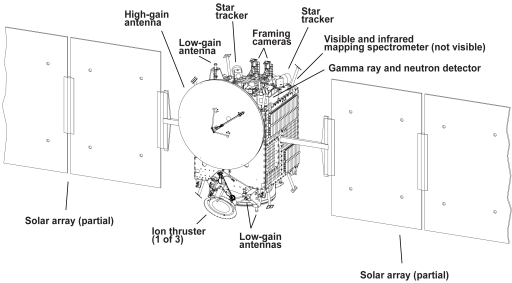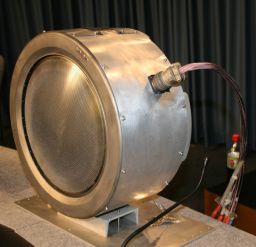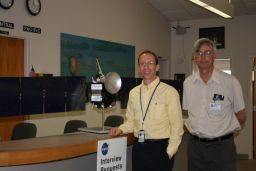Emily Lakdawalla • Sep 26, 2007
Dawn launch: One-on-one with Marc Rayman at Kennedy Space Center
Planetary Society volunteer Ken Kremer is reporting for us from the Kennedy Space Center, where he is anticipating the launch of Dawn on September 26. Kremer is a research scientist who spends his spare time giving public outreach presentations on behalf of The Planetary Society as a volunteer and NASA's Jet Propulsion Laboratory as a Solar System Ambassador. Thanks Ken! --ESL
Monday, September 24 I had the fortunate opportunity to have a lengthy conversation with Marc Rayman, who I met at the Kennedy Space Center (KSC), in his few moments of down time prior to launch and the formal pre-launch press conference. We discussed the launch vehicle, spacecraft, flight trajectories, and science goals of what is really a three-body mission: a flyby of Mars followed by orbital science at Vesta and Ceres in that order.
First on the launch status, Marc told me that "All second stage fuel had been loaded by early afternoon (Monday) and no issues are being worked at his time." He added that there are no obstacles to starting the final countdown at this point. Liquid oxygen loading begins just after T-80 minutes during the terminal countdown on launch day. Weather is beautiful at the Cape today. The Mission Dress Rehearsal this past Saturday went perfectly.
Some final pad work on the spacecraft remains to be completed, however. For example, Marc said that dust covers on two of the three ion thrusters still have to be removed. Readers may have seen these white covers on many pre-launch images, including the one visible in the image from my first report. Technicians at the pad have to retract these dust covers through 46-centimeter (18-inch) portholes in the payload fairing. Marc told me that dust covers for both star trackers and one VIR spectrometer cover are still to be removed as well. Workers at the pad must also reach in to arm the battery that will power the giant solar arrays. The hyrdazine fuel valves have to be properly configured manually by a human hand protected by a SCAPE (Self Contained Atmospheric Protected Ensemble) suit.
Round-the-clock operations start at the Jet Propulsion Laboratory in Pasadena, California at T-16 hours and will continue for up to a week after launch, depending on how the systems check out. According to Marc, All files are loaded onto Dawn and verified before the cryogenics are loaded. The team waits until this time to ensure that any last-minute patches to the software are included in the final package and are not mixed up with earlier versions.
The first 80 days following launch is the initial checkout period, during which all spacecraft systems are tested, verified, and configured. The ion engines need to be ready for interplanetary thrusting at this point.
nd many updated flight geometries are calculated and uploaded during this period. Marc mentioned that numerous fault protection modes are available to automatically correct for any anomalies detected. For example, if the spacecraft attitude is incorrect and a temperature-sensitive spectrometer or other instrument is incorrectly pointed to the sun and being excessively heated, fault protection will adjust Dawn to correct the situation and prevent damage.
Finally, we discussed the science goals of Dawn, which is why NASA approved this mission in the first place. Marc told me that some science operations will be conducted during the Mars encounter period by the three onboard science instruments . But these observations will be limited during the approach phase since Mars will be located only about 20 degrees from the sun. He said that both the Framing Camera (FC) and the Visible and Infrared Mapping Spectrometer (VIR) would run too hot to be operated safely. However, the Gamma Ray and Neutron Detector (GRaND) can and will collect approach data. All three science instruments will collect data on the outbound leg. Many dozens of images will be taken during the intense encounter period, which will last several days.

NASA / JPL
Diagram of the Dawn spacecraft
Only part of the solar arrays is shown. Each of the two solar arrays actually consists of five square panels. There is significant international participation on the Dawn mission. The Framing Cameras (FC) were built by the Max Planck Institute for Solar System Studies and the German Aerospace Center (DLR) and funded by Germany. The VIR spectrometer was funded by Italy and provided by the Italian Space Agency and the National Institute for Astrophysics (ASI INAF). GRaND was designed and built at Los Alamos National Laboratory. The Dawn spacecraft was designed and fabricated by Orbital Sciences Corporation.At Vesta and Ceres, Marc told me that Dawn will attain orbit by gravitational capture purely through the action of the ion thrusters, gradually spiraling in to an initial science orbit over a period of about three weeks at Vesta and more than a month at Ceres. All three science instruments will swing into action for intense data gathering operations to provide global maps and measure the elemental and mineralogical compositions of the surface and near surface. By measuring the gravity fields, scientists will be able to make some determinations of their interior structure as well.
Via the ion thruster, the orbit will then be lowered two more times at Vesta to a final altitude of about 200 kilometers, significantly increasing the resolution obtained with the cameras and spectrometers. Likewise at Ceres, Marc indicated that the initial orbit will be lowered over several months to 700 kilometers. Marc said that the ability to achieve these goals of lowering the orbit and increasing resolution is directly dependent on the amount of residual xenon propellant available. Ceres is known to possess vast quantities of water ice. Achieving a lower orbit will significantly enhance the science team's ability to answer fundamental questions such as whether this water exists as a liquid ocean. The answer to that question has tremendous implications in the search for life beyond Earth and whether a world such as Ceres possesses a habitable zone to support the evolution of life on another world. And that is why the science team must carefully balance the trade-offs on how best to utilize the finite quantity of xenon propellant available. Marc explained that at the end of the mission, the rules of planetary protection dictate that there must be a sufficient quantity of xenon available to prevent the spacecraft from crashing into Ceres and potentially contacting and possibly harming alien life forms.
Finally, waxing philosophical, Marc said that "the work on this mission is difficult. There are no guarantees in the space business. We are traveling to unfamiliar worlds, which are poorly understood and with unknown gravity fields. So the science payoff is BIG ! Great rewards can only be attained with great challenges."
Support our core enterprises
Your support powers our mission to explore worlds, find life, and defend Earth. You make all the difference when you make a gift. Give today!
Donate

 Explore Worlds
Explore Worlds Find Life
Find Life Defend Earth
Defend Earth



